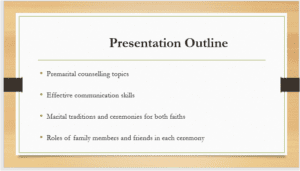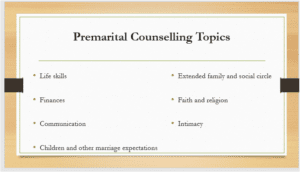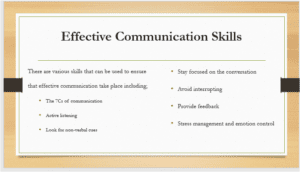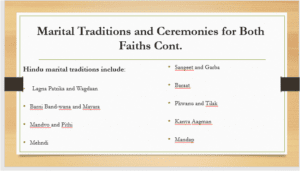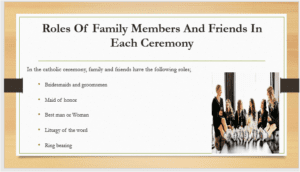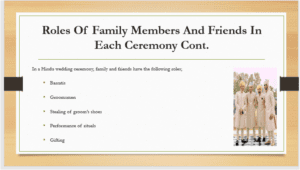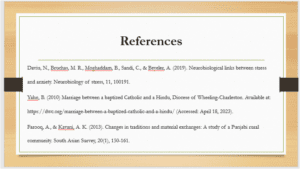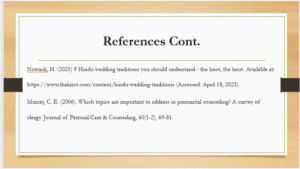MARRIAGE PLANNING PRESENTATION
Hello and welcome to my marriage planning presentation for two of my friends who are getting married. This presentation aims to provide details on various elements or conditions that my friends, who are of different faiths (Catholic and Hinduism), have to meet to prepare for the final ceremony, which is the wedding.
Here is the outline of this presentation. I will start by describing the various premarital counseling topics that must be examined before the ceremony. Next, I will talk about the necessary effective skills the couple needs to negotiate elements of the wedding and their future decisions positively. The third point I will discuss is the couple’s marital traditions and ceremonies based on their faiths. Lastly, I will define the roles of both families from both sides as well as the couple’s friends in each type of ceremony.
Premarital counseling is crucial for couples who have decided to get married because it helps them resolve any issues before committing a lifetime. Secondly, counseling will also help them set goals for the relationship. Accordingly, there are several topics that a couple can talk about during premarital counseling, and they include life skills. Life skills such as empathy, self-discipline, self-control, honesty, decision-making, self-awareness, and interpersonal relationship skills are some of the key elements to a successful marriage (Murray, 2006). In counseling, a couple works to identify what life skills they have and what they lack so that they can work to develop them. The second counseling topic is financing. Accordingly, one of the leading causes of divorce is the mismanagement of finances. Some of the things that the couple needs to address under finances is their experience with money, for example, whether they grew up in a rich family or how their parent(s) viewed money. These questions will help the couples understand each other’s relationship with money. In addition, under finances, the couple also needs to sit down and create a budget for their spending based on how much they each earn. The couple also has to figure out if they are comfortable with their financial position and what steps to take towards being financially secure. Lastly, the couple has to address the question of debt, including how much debt each of them has, how much debt they are willing to incur while in the marriage, and how they will pay off their debt. The third counseling topic is communication. This should be one of the first things addressed during counseling. The couple must learn how to talk openly to each other about anything and everything. The fourth counseling topic is children and other marriage expectations. Regarding children, the couple should address whether they want children, how many, and what parenting style they want to use. Other marriage expectations that the couple should address revolve around other matters like sex, dates, and even household chores. It is also important that the couple discuss whether their expectations are realistic. The next counseling topic is an extended family and their social life. The couple must agree on healthy boundaries between their marriage, family, and friends. For example, how often they should visit them, where and with whom they spend their holidays, how to prevent intrusiveness from them, and how to handle disagreements with said extended family and friends. Next, faith and religion, especially for a couple with people from different faiths, are crucial topics in counseling. Due to differing faiths, the couple must address anything that can lead to conflict. This is especially important when it comes to raising children; the couple should be on the same page on how they want to religiously educate their children. Lastly, yet importantly, the couple should talk about intimacy. The couple should discuss being each other’s safe space that allows them to be vulnerable and share their inner thoughts. Marriage cannot work if the couple is not honest with each other about their needs.
For any relationship to succeed, there has to be good communication whereby both parties feel understood. Without understanding each other, people end up feeling disconnected. This is where the skills of effective communication come in. One of these skills is the seven Cs of communication, which include being clear, concise, complete, correct, compassionate, coherent, and courteous. The second skill of effective communication is active listening, which means that one should not only listen to the words being spoken but also understand the meaning behind said words. Ask questions when you do not understand, clarify when confused, and empathize with their feelings, beliefs, and thoughts. The third skill is looking out for non-verbal cues. While talking to someone, one must learn to pay attention to other non-verbal ways the body communicates. An example of a nonverbal cue is tone, high tone, or low tone to indicate different emotions. Body positioning, for example, crossed arms on the chest, could show anger. The next skill is learning to stay focused on the person talking. We are often distracted by things in our surroundings, and divided attention is impossible, meaning that one thing will be neglected. Neglecting a conversation can cause miscommunication and other negative consequences, like conflict due to misunderstandings. Avoiding interruption is another skill that one has to communicate well. Interruption makes a person feel unimportant and not worth listening to, but they are also disrespectful and a sign of self-centeredness. The next skill is providing feedback. In a relationship, a partner can devise an idea they think they should do, such as investing in real estate. This partner then talks to their partner about it. It is only fitting that they get feedback on their partner’s thoughts about their idea, whether they agree or not, and the reasoning behind it. Motion control, one has to not only control their emotion to avoid blinded judgment but also learn. The final practical skill for communication is stress management and emotional control. Stress has been linked to aggressive behavior (Daviu, et al., 2019). With that in mind, couples must learn to manage stressful situations so they do not end up hurting each other, especially during heated conversations. Not understanding your emotions means you cannot express them, leading to frustration and possibly conflict.
It is prudent that during this marriage planning process, the couple and everyone else should keep in mind how complicated interfaith wedding ceremonies can get. For one, the Catholic church primarily does not allow interfaith marriages to take place in their churches (Yahn, 2010) . However, the couple could find a neutral location that has to be approved by the Catholic minister for the wedding to take place. In addition, not all the marital traditions mentioned above will take place. For example, from the processional to the ring, the ceremony can be conducted. Still, the others will be foregone because the Catholic church does not allow partaking of sacraments or, rather, holy communion with other faiths. That means traditions will not take place from nuptial mass to nuptial blessing. Nevertheless, the ceremony can be conducted by a Catholic priest until the couple says their vows and is announced as husband and wife. The bride should wear a white gown while the groom must wear formal attire, preferably a suit, for this ceremony.
Regarding Hindu marital traditions, we start with lagna patrika, essentially the formal engagement ceremony where the couple announces their upcoming wedding. Another ritual is the wagdaan, which takes place during lagna patrika, whereby the couple exchanges a ring that represents a promise of marriage. The second tradition is the barn band-hwana which takes place fifteen days before the wedding (Nowack, 2021). This tradition is where mauli, a thread, is tied on the groom’s and his parent’s hands to ask for safety from the gods. Mayara also takes during this tradition and involves gifting the couple’s families with gifts from the maternal uncles of the couple. The third tradition is the mandir, also known as the haldi ceremony, a pre-wedding ceremony in which the couple is covered with turmeric paste. The yellow color of turmeric symbolizes purity, beauty, fertility, and warding off evil. The fourth tradition is mehndi, which involves the bride and the dear ones getting henna applied to their hands and feet. Sangeet and Garba are other preceding events that are less religious-focused than the others. This is about having fun and the families getting to know each other. Both families and friends are expected to perform songs and dances. The baraat is the first tradition that takes place on the wedding day. It is when the groom arrives at the wedding while decked out in Indian attire, possibly riding a horse or elephant if possible. The next tradition is the pokwanu and tilak, whereby tilak (a mark) is applied on the groom’s forehead, which signifies the bride’s family welcoming the groom. The next tradition is kanya Hagman, whereby a bride is led into the wedding venue under a canopy. After kanya Hagman, the couple is seated in a mandap, where the ceremony takes place, including circling the fire in the middle seven times.
Joota chupai involves the groom removing his shoes before entering the mandap. The fun behind this tradition is that other females in the wedding are allowed to steal the shoes and only give them back when the groom pays them some money (Farooq & Kayani, 2013). The next tradition is invoking Lord Ganesha so that he can remove any obstacles from the ceremony. Granthibandan involves the couple tying the knot literally, whereby the groom’s scarf is tied together with the bride’s shawl as the chant prayers. Havan and agni is a sacred fire ritual that honors the god of fire by putting ice or ghee in a fire. Kanyadan and hastamelap involve the bride’s father taking the bride’s right hand and placing it in the groom’s right hand. It is a symbolic ritual for giving away the bride (Nowack, 2021) . The ride’s mother also pours sacred water on the couple’s joined hands. Jai mala is when the couple exchanges floral garlands. Saptapadi is the ritual of taking seven steps around a fire. These steps represent vows that sanctify the union of the couple. Mangal sutra and son door is a ritual that involves putting a sacred necklace on the bride to signify the couple’s promise to stay together. It serves the same purpose as a ring. Aashirwad is a tradition whereby the couple receives blessings from their families as the ceremony ends. Lastly, the vidaai is when the couple exits from the wedding, bidding goodbye to their families.
Family and friends of the couple are allocated various roles ranging from maid of honor, best man, bridesmaid, flower girl or boy, and ring bearer, among others. The main role of the bridesmaid and groomsmen is to assist the couple in numerous tasks in wedding planning, ranging from delivering invitations, conforming RSVPs, designing said invitations, and planning bridal showers and bachelorette and bachelor parties, among others. In addition, people in these roles are also supposed to help the couple stay calm and relaxed during the wedding day and ensure they are comfortable, further, during the liturgy of the word. Friends and family can volunteer to read the Bible to the audience. Lastly, friends and family also have the role of flower girls or boys and presenting the rings to the couple as ring bearers.
During the groom’s entrance into the wedding venue, his friends, family, and groomsmen, collectively referred to as barratis, accompany him as they sing and dance for him. As mentioned before, female friends of the bride are tasked with stealing the groom’s shoes during the wedding, an act meant to bring more fun to the wedding. Families, especially parents, have multiple roles to play in a Hindu wedding. From welcoming the groom and applying tilak on his forehead, the bride’s father joined the couple’s right hands, the bride’s mother poured sacred water on the joined hands, and all the parents blessed the couple after the ceremony. Further, friends and families must come up with dances and songs for traditions like sangeet and garba. Lastly, the bride’s maternal uncles have the role of showering the couple’s families with gifts before the wedding ceremony.
ORDER A PLAGIARISM-FREE PAPER HERE
We’ll write everything from scratch
Question
Marriage Planning Presentation
Create an 8–10-slide presentation (excluding the title and reference slides) in which you are planning an interfaith wedding for your friends. You can choose the faith of each friend ( Catholic )
MARRIAGE PLANNING PRESENTATION
Include the following in your presentation:
Describe what premarital counseling topics should be examined prior to the ceremony (consider life skills, finances, communication, etc.).
Outline effective communication skills that will help the couple positively negotiate elements of the wedding and future decisions the couple must make together.
Identify the marital traditions and ceremonies of both faiths. Consider how to include traditional elements of both faiths within one ceremony.
Define the roles of family members and friends in each type of ceremony.
Include speaker notes below each content-related slide that represent what would be said if giving the presentation in person. Expand upon the information included in the slide, and do not simply restate it. Please ensure the speaker notes include a minimum of 50 words per content slide.


